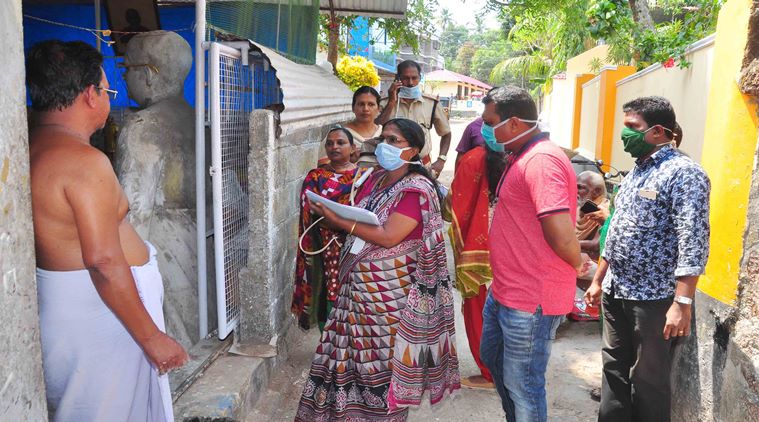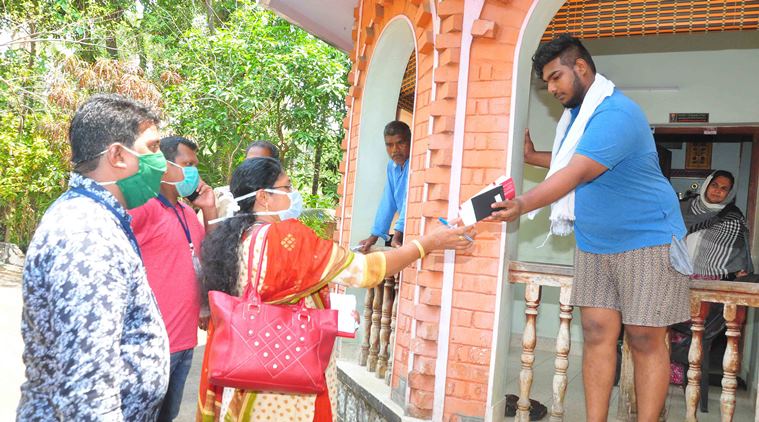Stay updated with the latest - Click here to follow us on Instagram
COVID-19: Any changes in migration pattern from Gulf will affect 80 lakh people in Kerala, says expert
Experts and government officials are wary about a new challenge: when a significant proportion of its 20 lakh-strong expatriate population in the Middle East start to return home once the national lockdown is lifted.
 Kerala’s early preparedness and its robust and decentralised disease surveillance system that made it possible to track down primary and secondary contacts of the foreign returnees and monitor them for symptoms quickly. Image: Kerala Govt PRD
Kerala’s early preparedness and its robust and decentralised disease surveillance system that made it possible to track down primary and secondary contacts of the foreign returnees and monitor them for symptoms quickly. Image: Kerala Govt PRD
Through a series of sustained contact tracing measures, relatively high testing of symptomatic patients and observance of strict quarantine, Kerala’s health department has been largely successful in flattening the curve of new infections and thus contain the spread of the pandemic in its second wave.
But experts and government officials are wary about a new challenge: when a significant proportion of its 20 lakh-strong expatriate population in the Middle East start to return home once the national lockdown is lifted.
For now, Kerala’s government officials have requested the local authorities in UAE, Saudi Arabia and other Gulf countries to ensure proper supply of food and medicines for its expatriates. “Stay where you are right now. Once the lockdown is lifted and flights begin to operate, you can come home,” is the message. However, officials are bracing for the wave of returnees and possible job losses.
Follow Coronavirus LIVE news Updates
“I would expect that close to 2-3 lakh migrants, which is around 10 per cent of the 20-lakh population in the Gulf, are likely to return by August-September. Priority migrants such as those with dependants, those whose visas have expired, pregnant women, elderly persons and children will be the first wave of returnees. The second wave will be the workers,” said S Irudaya Rajan, professor at the Centre for Development Studies in Thiruvananthapuram and a long-time expert on migration to the Gulf.
Read | As Covid-19 drowns temple festival season, Kerala’s elephant owners feel the blues
“By then, the government will have to think of a plan for the rehabilitation of the return migrants,” said Rajan, who’s also a member of the task force constituted by the Kerala government to propose easing of lockdown restrictions.
 Health officials carry out door-to-door checking in Kerala.
Health officials carry out door-to-door checking in Kerala.
Kerala’s relationship with the Gulf countries has always been special. For the last five decades, the state has been sending lakhs of its skilled and unskilled men and women to Gulf countries whose remittances in return have powered the state’s economic and social development. Such remittances in recent years have accounted for over 30 per cent of the state’s GDP, making the expatriate workforce key to Kerala’s progress. But since the 2008 global economic crisis and the fall of oil prices, income levels in the Gulf have not improved for a vast share of Malayalis who are now having to compete with those from Indian states as well as from countries like Pakistan, Bangladesh, Nepal and the Philippines. In countries like Saudi Arabia and Oman, the Nitaqat, or naturalisation policy has also resulted in heavy job losses for migrants from Kerala.
Also Read | Pinarayi urges PM Modi to help bring back stranded expatriates
Now, with the International Monetary Fund (IMF) predicting global recession with effects surpassing those of the 1929 Great Depression, the fate of the state’s expatriates in the Middle East hangs in balance. With India’s economy suffering equally due to the lockdown, the returnees will have to compete hard with the locals for jobs.
 Kerala’s health department has been largely successful in flattening the curve of new infections and thus contain the spread of the pandemic in its second wave.
Kerala’s health department has been largely successful in flattening the curve of new infections and thus contain the spread of the pandemic in its second wave.
“It’s important to remember that one Malayali in the Gulf is supporting four people at home. So when we are talking about a 20-lakh workforce, they are actually supporting 80 lakh people back home in Kerala. That’s about one-third of the state’s population which will get directly affected by any changes in migration,” quipped Rajan.
Read | Kerala task force recommends four-phase easing of lockdown; trains and planes to start last
He said it’s unclear at the moment the scale of potential job losses for Malayalis in the Gulf and whether their remittances will take a hit because countries right now are focused on stemming the spread of the pandemic. “We are worried about the disease right now. We are talking about life and death. Livelihoods will come later once the crisis ends.”
Prof Rajan said the silver lining for Malayalis in the Gulf as opposed to their counterparts from other Indian states is the five-decade experience they have in combating years of recession and economic downturn and how they can use it to stay afloat.
Read | MHA lockdown guidelines: What’s allowed, what’s not
“Even during the 2008 crisis, I found that most of them in spite of losing jobs were staying back as they have a large network of family and friends. In 2-3 months, they find another job. Since there’s nothing they can fall upon back home, they think it’s better to remain there. As opposed to a first-time migrant from UP who will board the next flight out of there if he loses a job, a person from Kerala can afford to stay back as they can count on their networks,” he said.
Don’t miss these articles on Coronavirus from the Explained section:
‣ How coronavirus attacks, step by step
‣ Mask or no mask? Why the guidance has been shifting
‣ Besides a face cover, should I wear gloves when I go outdoors?
‣ How the Agra, Bhilwara and Pathanamthitta Covid-19 containment models differ







